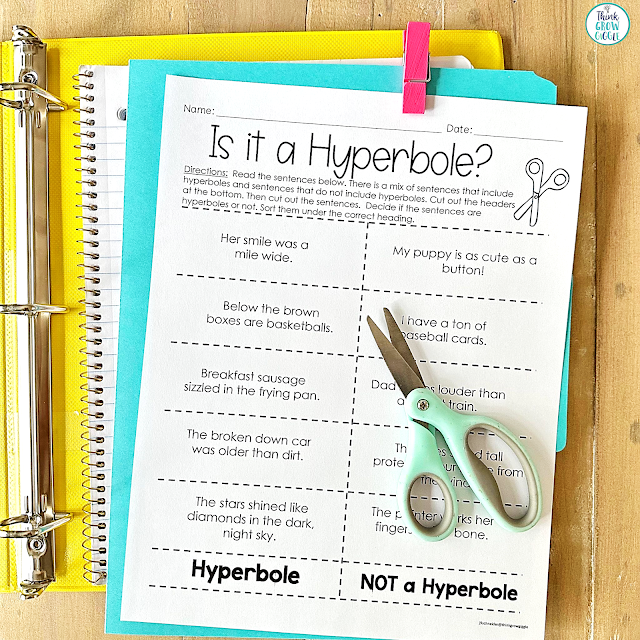I love teaching figurative language!
I love teaching all different forms of figurative language, even ones that are not “addressed” in the grade level standards. Teaching students about the different forms of figurative language helps students both as readers and writers. Simply put, when students understand all the nuances of figurative language, they are better able to comprehend as readers and craft stories as writers.
While I love figurative language, I know that there is only
so much time in a day! Once figurative language has been introduced, it is easy
to come back to frequently and naturally as you read aloud books that are filled with amazing examples!
In addition to pulling out examples from the books you read, these quick tips will help you and your upper elementary students dive deep into figurative language.
1. Create a Reference Bulletin Board Display
Help students see different forms of figurative language visually by creating a bulletin board or chart paper display and leaving it up all year long as a reference tool. Having a dedicated area to showcase different forms of figurative language is helpful to refer to when examples come up in the books that you read. It is also inspirational and helpful to students as writers to refer to when writing and revising their written pieces.
Teacher Tip: Don't wait to hang up a figurative language display until after you teach it! Having a display ignites student curiosity and interest, helping them to learn at a deeper level, even independently!
2. Reading as Writers
When we learn about figurative language, we use the term “reading as writers” to help us focus on finding figurative language in the books that we read. As readers, we can better understand the author's language and message using figurative language. As writers, we can create stories that will hold our readers' attention.
We use these "Frequent Figurative Language" punch cards to find different examples of figurative language as we read. This holds students accountable as readers, and it also holds them accountable for now including that form of figurative language in their writing! It is a fun and easy way to help students engage with the texts that they read!
3. Hands On Figurative Language
Sorts are such a great "hands on" way to help students differentiate between the many different forms of figurative language that they learn about as readers and writers. To create a sort, simply write out different examples of figurative language that you found with students and have them sort them!
You can have your students sort the examples based on what type of figurative language the example is, or you can focus on one form of figurative language. If you focus on one type of figurative language, have two headers for students to sort under. For example, if you are focusing on similes, your headers would be "similes" and "not similes." Sorts are great to use with any form of figurative language at any point during your figurative language unit and all year long!
Figurative language games are also always a hit with my students! The students love to play again and again and will always pull out these games during indoor recess and bus dismissal time! Grab print and go figurative language games in THIS SET.
Teacher Tip: Try this FREE hands-on activity to get kids giggling and learning about alliteration and tongue twisters at the same time!
4. Have High Expectations
This is a simple tip but very powerful. Have high expectations of your students, both as readers and writers, when it comes to figurative language. Hold them accountable for including different forms of figurative language in their writing pieces. Try giving them specific goals before they write, like "Be sure to include two similes in your writing today." You can also give them task specific editing and revising tasks, like, "As you revise your writing today, find a spot to add a metaphor." These specific and direct task holds students accountable, and they will work to complete the challenge!
Another way to hold students accountable for including figurative language in their writing is by having figurative language student author shares. These can be quick shares. Students select only one portion of their writing to share with the class. The class listens for their example of figurative language, identifying it in the writing and stating which form of figurative language it is. Go one step further and have the students explain what they visualized as they heard that form of figurative language.
Teacher Tip: If you use a writing checklist, include figurative language on the checklist as an extra reminder. Including a variety of figurative language in their writing is not out of reach for students, they can do it!
5. Picture Book Read Alouds
If you are an upper elementary teacher, you probably read all different chapter books throughout the year. And yes, chapter books have figurative language woven throughout, I have found that picture books with illustrations offer that visual support that students need to help them make sense of tricky figurative language examples!
Need some ideas for read-alouds to help you focus on figurative language? Try this list! (list coming soon!)
When you teach figurative language to your upper elementary students, be sure to present it as an important part of BOTH their reading and writing lives. The more they find and discuss figurative language in the books that they read, the more they will include it in the stories that they write! Try these tips to help students truly understand, differentiate, and use figurative language!





















